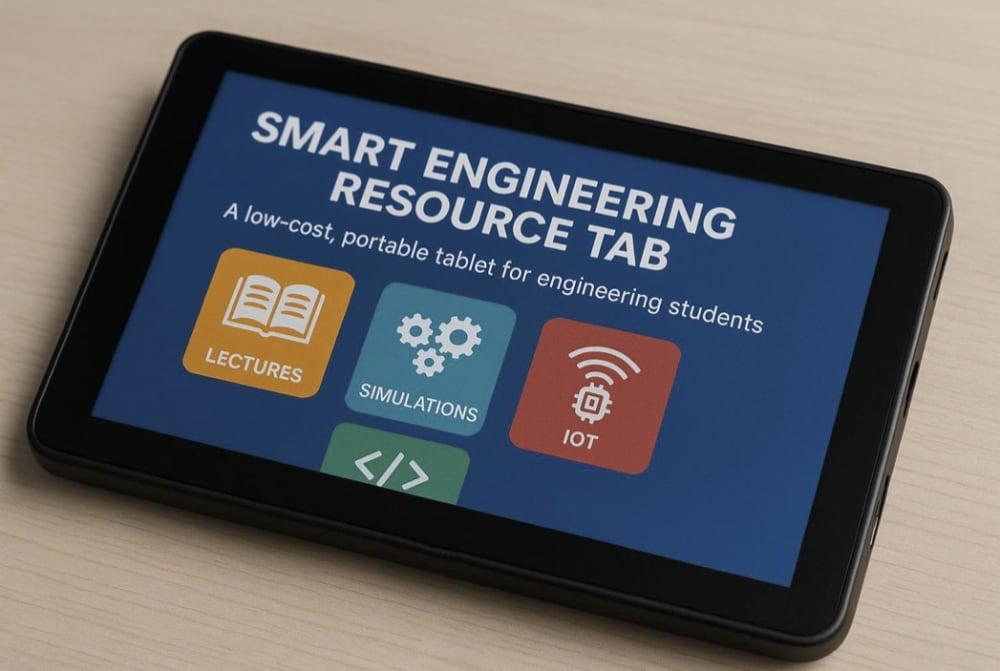The Smart Engineering Resource Tab is an innovative, low-cost tablet designed to empower engineering students with an all-in-one hub for learning, prototyping, and collaboration. Tailored for electronics, mechanical, and other disciplines, this portable device integrates preloaded resources, simulation tools, and IoT connectivity to streamline academic and project work, making STEM education accessible globally, especially in resource-constrained regions.
Preloaded with open-source textbooks, LTspice, KiCAD, and Arduino IDE, the tab provides offline access to critical resources, including Mouser’s component catalog for quick reference. Powered by an Intel Atom processor, it supports a lightweight Linux OS and a Python-based GUI, ensuring ease of use. A built-in Arduino-compatible microcontroller and GPIO pins enable direct hardware prototyping, while an ESP32 module offers Wi-Fi/Bluetooth for cloud syncing and collaborative tools like shared whiteboards. Analog Devices’ ADP5301 and LTC2944 optimize battery life, with an optional solar charging strip (ADP5091) for sustainability. COMSOL Multiphysics validates power and thermal designs, enhancing reliability.
Developed by undergraduate electronics students, this project leverages Mouser’s components, Intel’s processing power, Analog Devices’ energy solutions, and COMSOL’s simulation tools. Prototyped in 4–6 months using affordable parts. Energy efficiency is ensured through Analog Devices’ power management ICs and optional solar charging. The tablet can be built using a Raspberry Pi or Intel NUC, ESP32, and touchscreen within a budget of $50–150, making it feasible for undergraduate students with basic skills in Arduino, Python, KiCAD, and Linux. This project fits the Create the Future Design Contest theme by offering an innovative, accessible solution that enhances STEM education globally—especially in underserved regions—while showcasing the synergy of sponsor technologies in a practical, student-friendly form.or a better future.
Key Features
- Preloaded Engineering Resources:
- Open-source textbooks, tutorials, and reference manuals for subjects like circuit design and programming.
- Pre-installed software: LTspice, KiCAD, Arduino IDE, and MATLAB (stu- dent version).
- Offline access to Mouser’s component catalog and datasheets.
- Hardware-Optimized Development Environment:
- Powered by an Intel Atom or Celeron processor for efficient software ex- ecution.
- Built-in Arduino-compatible microcontroller for direct hardware inter- facing.
- USB/GPIO pins for connecting to sensors or prototyping boards.
- Simulation and Design Tools:
- Lightweight COMSOL Multiphysics interface for circuit and thermal sim- ulations.
- Basic AI assistant (using Intel’s OpenVINO) for guiding simulation setup and coding.
- IoT and Collaboration Features:
- ESP32 module for Wi-Fi/Bluetooth connectivity to sync notes or projects to the cloud.
- Collaborative tools like shared whiteboards and real-time code editors.
- Integration with university LMS (e.g., Moodle) for assignment tracking.
- Energy-Efficient Design:
- Analog Devices’ ADP5301 for battery optimization and LTC2944 for mon- itoring.
- Optional solar charging strip using ADP5091 for extended use.
- Low-power e-ink or LCD display for reading with minimal battery drain.
Applications
- Academic Support: Instant access to resources, reducing reliance on internet or expensive software.
- Project Work: Enables circuit prototyping, coding, and simulations on a single device.
- Collaboration: Supports group projects via cloud syncing and real-time tools.
- Global Impact: Affordable design enhances STEM education in resource-constrained regions.
Like this entry?
-
About the Entrant
- Name:Janasruthika P R
- Type of entry:teamTeam members:
- JEEVIKA HARSHINE S
- PRASANNAVADHANA V
- JAYAPRABHA
- Software used for this entry:Figma,Raspberry Pi,Linux
- Patent status:none


